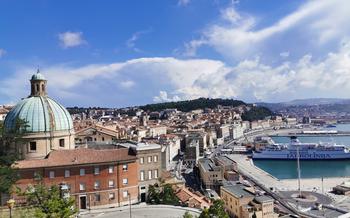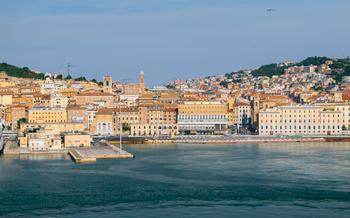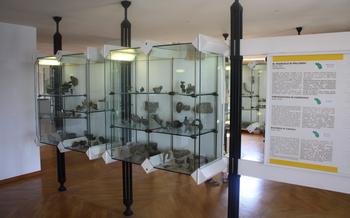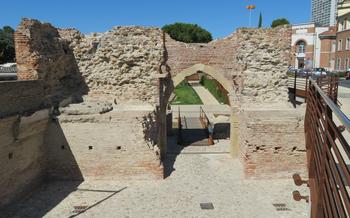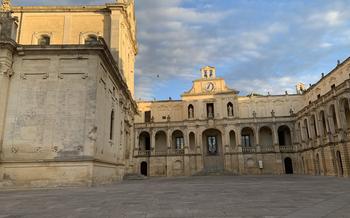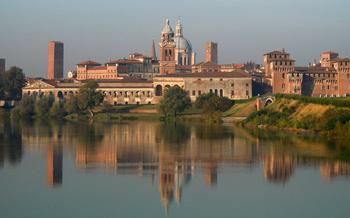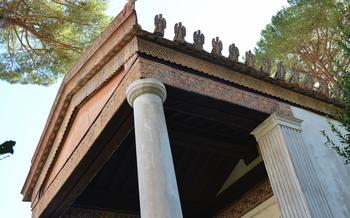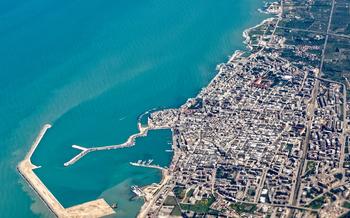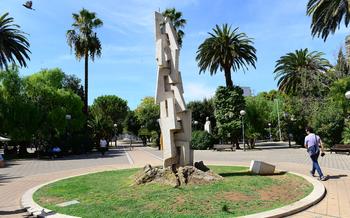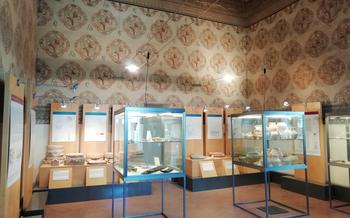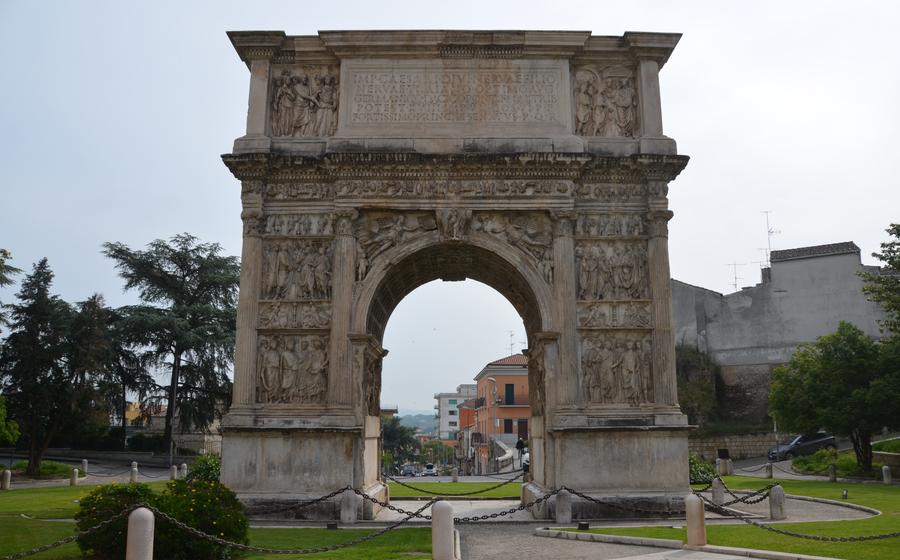
Arch of Trajan (Arco di Traiano)
- Ancona and the Arch of Trajan: A Journey Through Time
- Historical Context: Unveiling the Rich History of the Arch of Trajan
- Architectural Marvel: Exploring the Intricate Details of the Arch's Design
- Inscription and Symbolism: Deciphering the Messages Conveyed by the Arch
- Location and Surroundings: Setting the Stage for the Arch's Presence
- Preservation and Restoration: Ensuring the Legacy of the Arch for Future Generations
- Visiting the Arch: Unveiling Its Grandeur
- Historical Significance
- Artistic and Cultural Value
- Local Legends and Folklore: Uncovering the Stories and Traditions Surrounding the Arch
- Interesting Facts and Anecdotes
- Impact on Tourism
- Interactive Experiences: Unveiling the History and Significance of the Arch of Trajan
- Recommended Itineraries: Crafting a Perfect Ancona Itinerary
- Insider Tip: Unveiling a Hidden Gem or Unique Perspective
Ancona and the Arch of Trajan: A Journey Through Time
Nestled along the enchanting Adriatic coast, the ancient city of Ancona, Italy, invites travelers to explore its rich historical tapestry. One of the city's most iconic landmarks, the Arch of Trajan, stands as a testament to the grandeur of the Roman Empire and the achievements of Emperor Trajan. This awe-inspiring monument, erected in 115 AD, commemorates Trajan's victorious return from the Dacian Wars.
Located at the entrance to the ancient city, near the picturesque port, the arch serves as a gateway to Ancona's fascinating past. Its strategic position reflects the importance of Ancona as a strategic port city and a vital hub of trade and commerce. To fully appreciate the arch's significance, it is best to visit during the spring or fall, when the weather is pleasant, and the crowds are smaller. Immerse yourself in the history and beauty of Ancona, and let the Arch of Trajan transport you back to the glorious days of the Roman Empire.
Historical Context: Unveiling the Rich History of the Arch of Trajan
The Arch of Trajan stands as a testament to the military prowess and imperial grandeur of ancient Rome. Its construction was commissioned by the Roman Senate to honor Emperor Trajan's triumphant return from the Dacian Wars, which took place from 101 to 106 AD. Trajan's successful campaigns against the Dacians, a fierce people inhabiting present-day Romania, expanded the Roman Empire's borders and brought immense wealth and prestige to Rome.
The arch was erected in 114 AD, marking the culmination of Trajan's reign and his contributions to the empire's expansion. Its strategic location at the entrance to the ancient city of Ancona, a port city on the Adriatic Sea, served as a symbolic gateway to the empire and a reminder of Trajan's military might. The arch's construction showcased the power and influence of the Roman Empire, demonstrating its ability to conquer and control vast territories and its commitment to imperial expansion.
The arch's design and iconography were carefully crafted to glorify Trajan's achievements and convey a message of imperial authority. Its elaborate carvings and bas-reliefs depict scenes from Trajan's Dacian campaigns, immortalizing his victories and the submission of the conquered people. The intricate details and symbolism of the arch communicated the emperor's power, his connection to the gods, and the divine favor that guided his military triumphs.
The Arch of Trajan serves as a tangible reminder of the grandeur and power of the Roman Empire during Trajan's reign. Its historical significance lies in its commemoration of Trajan's military victories, its representation of Roman imperial authority, and its enduring legacy as a symbol of Rome's military prowess and architectural achievements.
Architectural Marvel: Exploring the Intricate Details of the Arch's Design
The Arch of Trajan stands as a testament to Roman engineering and architectural prowess. Its imposing dimensions, measuring 15 meters in height and 5 meters in width, create a sense of awe and grandeur. Constructed primarily from white limestone, the arch features a single, elegant archway flanked by two smaller pedestrian arches, allowing for the passage of vehicles and pedestrians alike.
The arch's exterior is adorned with intricate carvings and bas-reliefs that depict scenes from Trajan's Dacian campaigns. These carvings showcase the remarkable skill of Roman artisans and provide a glimpse into the historical events that led to the arch's construction. The architrave, the horizontal beam above the main archway, bears an inscription honoring Trajan and commemorating his victories.
The Arch of Trajan's architectural style is a blend of classical Greek and Roman influences. The Corinthian columns that flank the main archway, with their acanthus leaf capitals, are a nod to Greek architectural tradition. The triumphal arch form itself, however, is a distinctly Roman innovation, symbolizing the emperor's power and authority. The arch's design served as a model for many subsequent Roman triumphal arches, influencing the architectural landscape of the Roman Empire for centuries to come.
Inscription and Symbolism: Deciphering the Messages Conveyed by the Arch
The Arch of Trajan is adorned with intricate inscriptions and symbolic imagery that offer profound insights into the messages it conveys. The Latin inscriptions, carefully carved into the arch's surface, serve as a testament to the achievements and virtues of Emperor Trajan. They proclaim his triumphs in the Dacian Wars, his dedication to justice and peace, and his embodiment of Roman values.
The arch's bas-reliefs, with their intricate carvings, tell a visual story of Trajan's military prowess and his role as a victorious leader. They depict scenes of battle, processions, and allegorical figures that symbolize virtues such as courage, strength, and wisdom. These elaborate carvings not only glorify Trajan's accomplishments but also serve as a powerful reminder of the might and grandeur of the Roman Empire.
The arch's iconography is a carefully crafted blend of Roman and Hellenistic influences, reflecting the cultural synthesis that characterized the Roman Empire. The arch's design and symbolism were meticulously chosen to convey a message of imperial power, authority, and legitimacy. It served as a statement of Rome's dominance and its commitment to maintaining peace and stability throughout its vast territories.
Interpreting the arch's iconography and symbolism allows us to gain a deeper understanding of Roman political ideology and the importance of propaganda during the imperial era. The arch stands as a testament to the enduring power of symbols and the role they played in shaping the narrative of Roman history.
Location and Surroundings: Setting the Stage for the Arch's Presence
The Arch of Trajan stands as a majestic gateway to the ancient city of Ancona, its imposing structure greeting travelers and visitors alike. Strategically positioned at the entrance to the port, the arch serves as a symbolic threshold between land and sea. Its proximity to the Adriatic Sea adds to its grandeur, creating a picturesque backdrop for this architectural masterpiece.
Beyond its position as a gateway, the arch is surrounded by a rich tapestry of historical and cultural attractions. Within walking distance, visitors can explore the Museo Archeologico Nazionale delle Marche, which houses a collection of artifacts from Ancona's ancient past. The nearby Cathedral of San Ciriaco, with its stunning Romanesque architecture, is another must-see for history enthusiasts.
The arch's integration within the urban fabric of Ancona is seamless, forming an integral part of the city's identity. Its presence as a gateway not only signifies the entrance to the ancient city but also symbolizes the enduring legacy of the Roman Empire and its lasting impact on Ancona's history and culture.
Preservation and Restoration: Ensuring the Legacy of the Arch for Future Generations
The Arch of Trajan, standing tall for over two millennia, has undergone various modifications and restoration efforts to preserve its grandeur and historical significance. Initially constructed using sturdy materials and advanced construction techniques, the arch has withstood the ravages of time. However, it has not been immune to the impact of historical events, natural disasters, and weathering.
Over the centuries, the arch has undergone several modifications and repairs. During the Middle Ages, the arch was incorporated into the city walls of Ancona, providing it with additional support and protection. In the 19th century, a major restoration project was undertaken to address the effects of weathering and natural disasters. This renovation involved reinforcing the arch's structure, repairing damaged carvings, and cleaning the stone surfaces.
In recent years, ongoing conservation measures have focused on preserving the arch's original appearance while ensuring its stability. Regular maintenance and monitoring are carried out to identify and address any potential issues. The arch's current condition is stable, and it continues to be a testament to the enduring legacy of Roman engineering and artistry.
Visiting the Arch: Unveiling Its Grandeur
Prepare to be awestruck as you approach the Arch of Trajan, a magnificent relic of the past that stands tall, inviting you to discover its grandeur. Whether you're an independent traveler or part of an organized group, accessing the arch is a breeze.
Historical Significance
The Arch of Trajan in Ancona stands as a testament to the grandeur and power of the Roman Empire during the reign of Emperor Trajan. Erected in 115 AD to commemorate Trajan's victorious return from the Dacian Wars, the arch serves as a tangible reminder of Rome's military might and engineering prowess. Its strategic placement at the entrance to the ancient city of Ancona symbolized the empire's dominance over the region and its control of the Adriatic Sea.
The arch bears witness to Trajan's successful campaigns against the Dacians, a fierce tribe that had posed a significant threat to the empire's eastern borders. Trajan's victory not only expanded the empire's territories but also brought immense wealth and prestige to Rome. The arch, with its elaborate carvings depicting scenes from the Dacian Wars, served as a powerful symbol of Trajan's achievements and the empire's unwavering strength.
Beyond its military significance, the Arch of Trajan also embodies the cultural and artistic achievements of the Roman Empire. Its intricate bas-reliefs, depicting both historical events and allegorical figures, showcase the empire's mastery of storytelling through art. The arch stands as a testament to the Roman Empire's enduring legacy, its influence on Western civilization, and its enduring fascination for history buffs and travelers alike.
Artistic and Cultural Value
The Arch of Trajan stands as a testament to the artistic and cultural prowess of the Roman Empire. Embodying the grandeur of Roman architecture, it is a masterpiece of engineering and artistry. The arch's design showcases the influence of both Greek and Etruscan art, blending elements from these two rich traditions to create a unique Roman style. The intricate carvings and bas-reliefs that adorn the arch are a testament to the skill and precision of Roman artisans. Depicting scenes from Trajan's Dacian Wars, these reliefs offer a glimpse into the historical context of the arch's construction. The collaboration between architects, sculptors, and artisans resulted in a cohesive and visually stunning work of art that has stood the test of time, inspiring and influencing generations of artists and architects. The Arch of Trajan remains a symbol of Rome's artistic and cultural heritage, embodying the empire's enduring legacy of creativity and innovation.
Local Legends and Folklore: Uncovering the Stories and Traditions Surrounding the Arch
The Arch of Trajan has become a source of inspiration for local legends and folklore, adding a layer of mystique and wonder to its historical significance. One popular myth tells the tale of a hidden treasure buried beneath the arch, believed to be a vast fortune left behind by Emperor Trajan himself. Treasure hunters have searched for centuries, but the secret of the treasure remains a closely guarded secret.
Another legend speaks of a mystical connection between the arch and the sea. Local fishermen claim that on certain nights, the arch glows with a faint blue light, a phenomenon attributed to the spirits of ancient sailors who lost their lives at sea. They believe that the arch serves as a guide, helping lost souls find their way home.
Over the years, the arch has become a symbol of good luck and protection for the people of Ancona. Many believe that passing through the arch brings good fortune and wards off evil spirits. It is customary for locals to touch the arch as they pass, a gesture said to bring blessings and prosperity.
These legends and traditions have become an integral part of the arch's identity, passed down through generations and adding to its allure. They serve as a reminder of the rich cultural heritage that surrounds this ancient monument, making it not just a historical relic but a living symbol of Ancona's history and folklore.
Interesting Facts and Anecdotes
Unraveling little-known tales about the arch
-
During the Middle Ages, the Arch of Trajan served as a tollgate, where travelers and merchants had to pay a fee to enter the city.
-
In the 16th century, the arch was incorporated into the city walls to strengthen the fortifications and protect Ancona from potential attacks.
-
According to a local legend, the arch was once adorned with a golden statue of Trajan, which was believed to have been struck by lightning and destroyed during a thunderstorm.
-
In the 19th century, the arch became a popular gathering place for artists and intellectuals, who would often meet under its impressive structure to discuss philosophy, art, and literature.
-
During World War II, the arch suffered significant damage from Allied bombings, but it was later painstakingly restored to its former glory.
Impact on Tourism
The Arch of Trajan stands as a testament to Ancona's rich history and cultural heritage, attracting a steady stream of visitors from around the world. Its enduring significance and beauty have made it a cornerstone of Ancona's tourism industry, drawing history buffs, architecture enthusiasts, and sightseers alike. The arch's presence has transformed the city into a cultural destination, offering a glimpse into the grandeur of the Roman Empire and the achievements of Emperor Trajan.
Tourism campaigns and guidebooks often feature the Arch of Trajan as a must-see attraction, highlighting its historical significance and architectural splendor. Social media platforms further amplify its appeal, showcasing captivating images and stories that pique the interest of potential visitors. The arch's unique charm and historical allure have turned it into an Instagrammable landmark, encouraging travelers to share their experiences and inspiring others to embark on their own journeys to Ancona.
Interactive Experiences: Unveiling the History and Significance of the Arch of Trajan
To further enhance visitors' understanding and appreciation of the Arch of Trajan, several interactive experiences have been developed. Virtual reality (VR) tours offer an immersive journey back in time, allowing visitors to step into the shoes of ancient Romans and experience the arch as it would have been in its prime. Augmented reality (AR) apps provide an interactive overlay of historical information, bringing the arch's intricate carvings and reliefs to life.
Interactive displays and exhibits at nearby museums and cultural centers offer deeper insights into the arch's construction, historical context, and symbolic significance. These exhibits may include touchscreens with detailed timelines, 3D models, and multimedia presentations that bring the arch's story to life.
Educational workshops and activities are available for families and students, providing hands-on opportunities to learn about Roman architecture, engineering, and history. These workshops may involve building model arches, creating replicas of Roman coins or mosaics, or participating in interactive quizzes and games.
Themed events and festivals are organized throughout the year to celebrate the arch's history and cultural significance. These events may include historical reenactments, guided tours by costumed actors, traditional Roman music and dance performances, and educational activities for children.
Recommended Itineraries: Crafting a Perfect Ancona Itinerary
When planning your visit to Ancona, consider crafting an itinerary that allows you to fully experience the city's rich history and cultural offerings. Here are some suggestions:
-
History Buffs: Start your day at the Arch of Trajan, immersing yourself in the grandeur of ancient Rome. Proceed to the Museo Archeologico Nazionale delle Marche to explore artifacts from Ancona's past. Conclude your journey at the Pinacoteca Civica Francesco Podesti, showcasing local art from the Middle Ages to the present.
-
Art Enthusiasts: Begin your artistic voyage at the Arch of Trajan, marveling at its intricate carvings. Continue to the Museo Diocesano, housing a collection of sacred art and sculptures. Next, visit the Palazzo del Popolo, where you can admire Renaissance and Baroque masterpieces. End your day at the Galleria d'Arte Moderna, showcasing contemporary Italian art.
-
Families: Make the Arch of Trajan your starting point, engaging the kids with stories of ancient Roman triumphs. Proceed to the Museo Tattile Statale Omero, a tactile museum offering a unique sensory experience for all ages. Afterwards, visit the Parco del Cardeto, a vast urban park with playgrounds, a lake, and stunning views. Conclude your day with a gelato stroll along the picturesque Passetto Beach.
Insider Tip: Unveiling a Hidden Gem or Unique Perspective
For a truly unique perspective of the Arch of Trajan, venture to the nearby Passetto di Ancona, a panoramic walkway that offers breathtaking views of the arch and the surrounding cityscape. As you stroll along this elevated promenade, you'll be treated to unparalleled vistas of the arch framed against the backdrop of the Adriatic Sea. Capture stunning photographs from this vantage point, where the arch's grandeur is amplified by the vastness of the sea and sky. Experience the arch in a new light, away from the hustle and bustle of the city center, and immerse yourself in the tranquility and beauty of this hidden gem.
